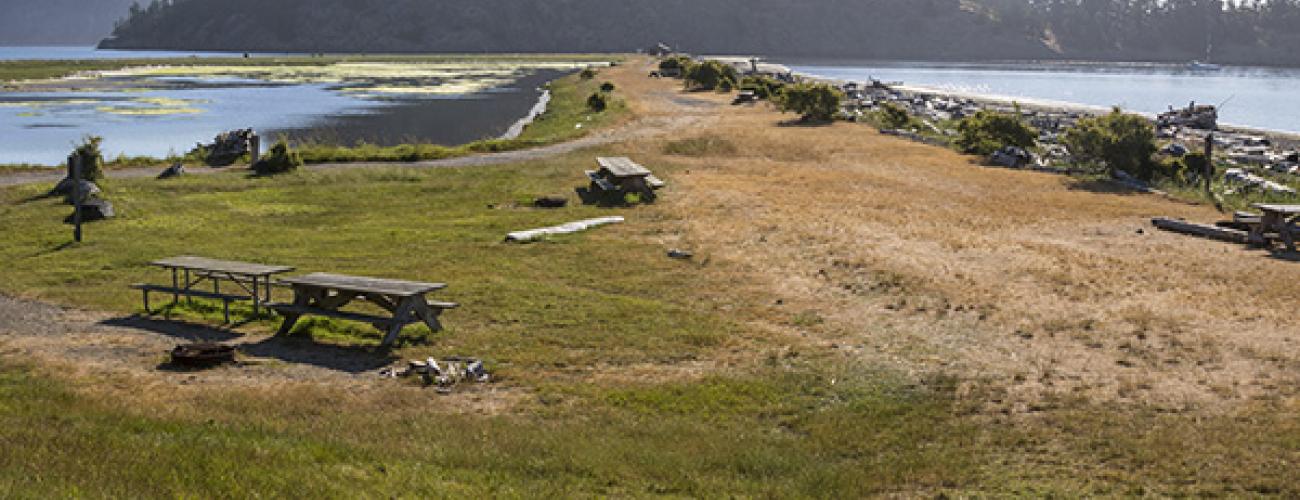Spencer Spit State Park History
A Spit of Land
The formation of a sand spit extending outward from a headland requires three things:
- A large source of unconsolidated sand and gravel adjacent to the beach
- Prevailing winds at an angle to the shore to nudge it away from the source toward a new resting place
- Convergence of nudging currents acting from opposite directions under the influence of the surrounding landmasses.
Spencer Spit's location on the east shore of Lopez Island has all these features, and the process of its formation continues each day, slowly moving sediment from the feeder bluffs on either side of the spit toward its tip.
Indigenous Lands
Spencer Spit lies within the traditional territories of Coast Salish Indigenous people whose present-day descendants include members of the Samish Indian Nation, Swinomish Indian Tribal Community and Lummi Nation. For thousands of years the rich waters of the San Juan Archipelago have provided habitat for a diverse community of life that forms the basis of their cultures. As winter days lengthen into spring, herring and herring roe collect in the eelgrass beds near shore. A little later, spring Chinook salmon pass through the island channels. Early summer brings sockeye salmon, harvested for millennia with reef nets. Sea urchins are gathered by expert divers in late summer, and clamming peaks in the fall.
Local tribes ceded ownership of the area to the US federal government under duress in the Treaty of Point Elliot in 1855, keeping rights to harvest natural resources in their usual and accustomed places, including the lands and waters around Lopez Island. After government land surveys were completed in 1875, European-American homesteaders began looking for ideal sites to claim.
Homesteaders
Theodore and Katherine Spencer stayed on the spit in the 1880s, but ultimately obtained a Homestead Entry Patent on nearby Blakely Island in 1892. Their son Raymond S. Spencer was born on the spit on December 23, 1887.
The land making up today’s park passed into private ownership with a Homestead Entry Patent to Franklin and Keturah Troxell. Franklin was a Civil War veteran whose unit, the 14th Infantry Regiment of the Regular Army, saw action at Antietam, Fredericksburg and Gettysburg, among other engagements. He built a house overlooking the spit and raised crops and animals, fulfilling the homestead requirements. The patent was approved on August 4, 1891. Prior to receipt of the patent, the rights had been deeded to James O. Spencer. On June 1, 1915, the land was sold to James’ uncle, Walter V. Spencer, and his wife Villa. They in turn sold quarter shares of the property to others, including their nephew Raymond, coming full circle to the place of his birth.
On February 26, 1920, Raymond Spencer received a Cash Entry Patent for the 5 acres at the tip of the spit. A log cabin “in the style of the pioneers” was built on the land to serve as a guest house. Rebuilt twice, it stands as a popular attraction in Spencer Spit State Park.
Making a Park
On October 22, 1962, the Washington State Parks and Recreation Commission (WSPRC) received a letter from Raymond S. Spencer saying that all of the owners had formed a corporation, Spencer Spit Properties, Inc., with the intent of selling their property to WSPRC before their deaths, with a lifetime easement. The Commission expressed interest in the property and sought funding for the purchase.
On November 3, 1964, Washington voters approved Initiative 215, the Marine Recreation Lands Act, which authorized a tax on fuel used in watercraft for the acquisition of land for marine recreational purposes. Funds raised by the initiative were used on March 14, 1967, to purchase 130 acres from Spencer Spit Properties for $263,000. The adjacent tidelands were transferred to Spencer Spit State Park by Substitute House Bill 572, approved by Governor Daniel J. Evans on April 28, 1967. The park was dedicated at a ceremony on July 27, 1968, headlined by Governor Evans.
Water
Water is a precious commodity on Lopez Island. Nearly all fresh water comes from deep wells tapping groundwater aquifers. Due to the island’s unique position in the “rain shadow” of the Olympic Mountains, Spencer Spit receives half the precipitation of the mainland 50 miles to the east. Island aquifers recharge slowly. If a well near the island’s shore draws too much water, the aquifer can be intruded by seawater and is no longer usable for drinking water.
Planning for the development of Spencer Spit State Park took these conditions into consideration. Campground restrooms feature low-use fixtures and do not provide showers.
Sharing the histories of Washington’s state parks is an ongoing project. Learn more here.

